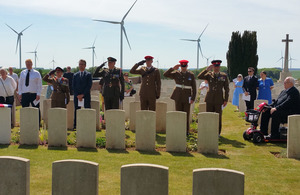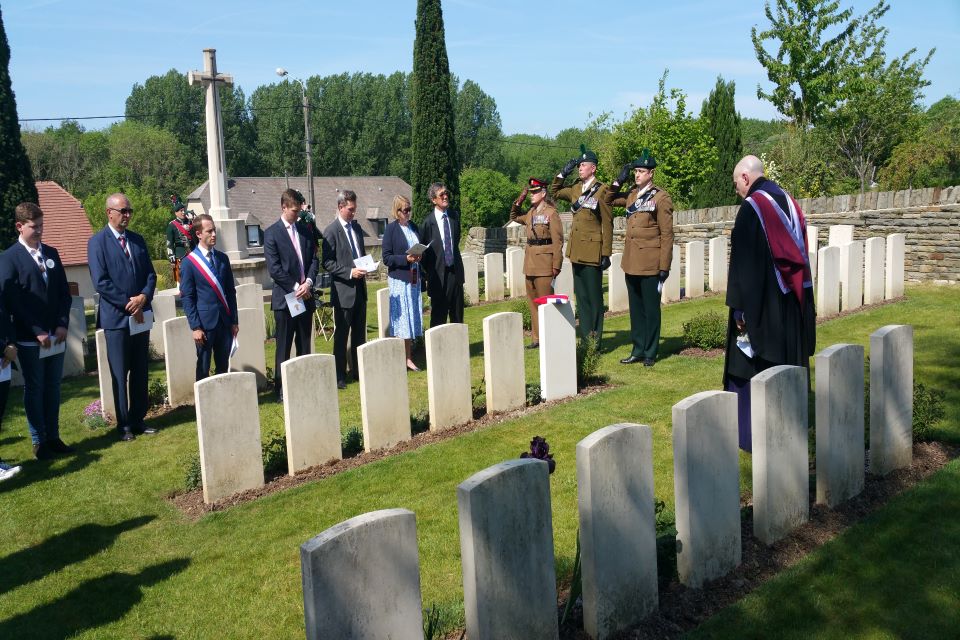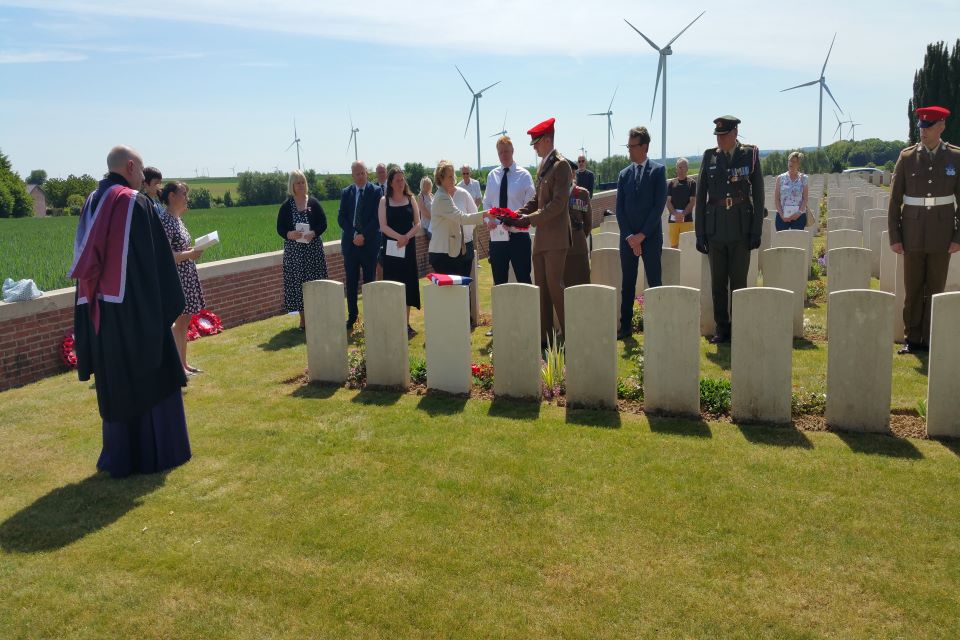Rededication services for Irish soldiers lost in the Great War
Rededication services are held in France for Lieutenant (Lt) Frederic Hornby Lever Rushton MC and Private (Pte) John Martin Roberts

The rededication service for Pte Roberts was attended by serving members of the British and Irish armies. Crown copyright.
The graves of Lieutenant (Lt) Frederic Hornby Lever Rushton MC and Private (Pte) John Martin Roberts, who died whilst serving with Irish regiments in the Great War, have been rededicated in France more than a hundred years after they died.
The services, which were organised by the MOD’s Joint Casualty and Compassionate Centre (JCCC), also known as the ‘MOD War Detectives’, were held at the Commonwealth War Graves Commission’s (CWGC) Montcornet Military Cemetery on 17 May and Queens Cemetery, Bucquoy, on 18 May.
Rosie Barron, JCCC case lead said:
“It has been a privilege to work with The Royal Irish Regiment and The Scottish and North Irish Yeomanry to organise these rededication services. Both Lt Rushton and Pte Roberts were amongst the first men sent to the Western Front in August 1914 as part of the British Expeditionary Force. Their fates were very different, but ultimately both men laid down their lives in service of others.
“Sharing this experience with their families brings their stories to life and ensures that their sacrifices are not forgotten.”
Lt Rushton, known as Hornby, was killed aged 26 whilst leading an assault on an enemy machine gun position on 15 September 1914 at Vailly-sur-Aisne, in eastern France. Having already been treated for a wound to his shoulder, he had been urged not to go back into the attack but he had insisted on doing so. Lt Rushton was serving with 2nd Battalion The Royal Irish Regiment and had been on the Western Front since 14 August 1914 and already taken part in the Retreat from Mons where he is said to have saved the life of his Commanding Officer and the Adjutant. Members of Lt Rushton’s battalion were given permission by a German Officer to recover his body. However, after the First World War Lt Rushton was found to be missing and he was commemorated on La Ferté-sous-Jouarre Memorial.

Captain Chris Rushton - Royal Irish Regiment - and great great nephew of Lt Rushton, attended the service alongside other family members. Crown copyright.
Lt Rushton’s great nephew, Nigel Salt, who attended the rededication service at Montcornet Military Cemetery along with his family, said:
“We are particularity grateful that Hornby’s grave has at last been identified and cannot thank enough all those involved that have made this possible. My Grandmother was totally devastated by the loss of both her brothers. This would at least have given her some consolation.”
Pte Roberts, aged 30, served with The North Irish Horse. He arrived on the Western Front on 17 August 1914, just days after Lt Rushton and like Lt Rushton took part in the Retreat from Mons and the Battle of the Aisne in 1914. In March 1918 The North Irish Horse was dismounted and became a Cyclist Battalion. Having survived almost the duration of the First World War, Pte Roberts was killed in an attack near the River Ancre on 21 August 1918. He was commemorated on the Vis-en-Artois Memorial. Two of Private Roberts’ brothers were also killed during the Great War, a third died of wounds following the conflict.

Captain Andrew Robertson of 'B' Squadron Scottish and North Irish Yeomanry, lays a wreath at the grave of Pte Roberts. Crown copyright.
The rededication service at Queens Cemetery, Bucquoy, was attended by members of Pte Roberts’ family, including his great grandson, Craig Roberts. Craig Roberts said:
“John Roberts’ involvement in WW1 was a long-forgotten story in my family. It wasn’t until I began researching my family tree that I discovered the sacrifice John and his brothers had made during the war. When I heard that John had been found, it made a person I had only read about online seem more real. Our family would like to give special thanks to Phillip Tardif, who investigated and linked John’s death and burial location, allowing John to be identified, thus enabling this ceremony to happen.”
The services were attended by representatives of the British and Irish Embassies as well as members of their families and serving soldiers of The Royal Irish Regiment and The Scottish and North Irish Yeomanry. They were conducted by the Reverend Dr Isaac Thompson MBE, TD, DL, HCF, Chaplain to The Royal Irish Regiment. As part of their engagement with MOD JCCC in the run up to today’s service, the Royal Irish Regiment realised that one of their soldiers was actually related to Lt Rushton. Captain Chris Rushton is Lt Rushton’s great-great-nephew. The soldier was invited to attend the service by his regiment and attended alongside other family members who were also present.
The Reverend Dr Thompson said:
“Lt Rushton, came from a village from near Wrexham, but joined the 2nd Battalion Royal Irish Regiment in 1909. In August 1914 he had reached the Front where he saved the life of his Commanding Officer and subsequently that of his Adjutant. Pte Roberts, was a young Irishman, born in Dublin. Both he and his two brothers, William and Albert, lost their lives in the conflict. How the family, back in Dublin, coped with the loss of three sons, one cannot begin to imagine.”
The location of Lt Rushton and Pte Roberts’ graves were discovered after researchers submitted evidence to CWGC suggesting that their final resting places could be identified. After further investigation by CWGC, the National Army Museum and JCCC, the findings of the researchers was confirmed by JCCC.
The headstones over their graves will now be replaced by the CWGC, who will care for their final resting places in perpetuity.
CWGC Commemorations Officer, David Avery, said:
“Thanks to the efforts of many and in the presence of their families, we are honoured to mark the graves of Lieutenant Frederic Hornby Lever Rushton MC and Private John Martin Roberts with new headstones bearing their names. The Commonwealth War Graves Commission ensures that all those who served and fell are commemorated by name and today we renew this commitment to caring for their graves, and their memory with dedication in perpetuity.”